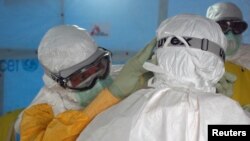The World Health Organization is issuing updated guidelines on proper use of personal protective equipment, or PPE, used in the fight against Ebola in West Africa.
WHO officials say the guidelines will help to protect health care workers from infection, but it notes the use of PPE is only one tool in the effort to prevent transmission of the deadly virus.
Other vital tools, they say, include the administrative and organizational setup for health care facilities, ventilation within these facilities, water and sanitation, and a host of approaches to assure nurses and doctors they can safely treat patients without infecting themselves and others.
Edward Kelley, WHO Director of Service Delivery and Safety, says research into how health care workers have been infected in this current Ebola outbreak shows the choice of PPE is much less important than the way it is used.
“It has not been the choice of the PPE that has caused the infection, it has been the way that PPE is put on and taken off, so the importance of appropriate training is highlighted in this document," he said. "It also lays out a set of principles around how the PPE should be used. Training health workers in using these, which would include mentoring and really engaging both before and during care, is fundamental.”
Basic guidelines
The WHO guidelines cover five basic areas. Dr. Kelley says the most important recommendation is for health workers to completely cover the mucous membranes of their eyes, mouth and nose in order to prevent virus exposure.
He says health workers should use either a face shield or goggles, and a fluid-resistant medical/surgical mask that is structured so it does not collapse against the mouth while caring for Ebola patients.
He says appropriate hand washing or use of a disinfectant is crucial in preventing the infection from spreading. But, he says, doing this in the field can be extremely difficult, so the WHO recommends "double gloving." The document also suggests how health workers should handle hand hygiene when they leave the area.
“There is an absolute recommendation on double gloving, which did not exist before," Kelley said. "It is a detail, but we also recommend the type of gloves, which are nitrile gloves. Latex gloves are discouraged. Those of you know latex tends to cause irritation and problems with the use of that sometimes.”
The guidelines also have recommendations on gowns, coveralls, and aprons, as well as appropriate footwear and head cover.
WHO suggests health care workers use one set of PPE per shift and dispose infectious waste in leak-proof bags and in covered bins. There are also guidelines on cleaning and disinfecting non-disposable items such as rubber boots.









